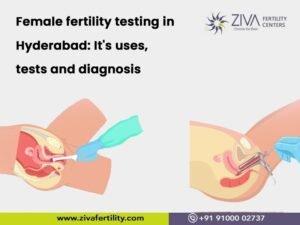One would be surprised to know that secondary Infertility is just as common as Primary Infertility. After having a child, if the couple is trying for another child and if they are unable to conceive or carry the pregnancy to full term, then it is termed Secondary Infertility. After trying unsuccessfully to conceive for six months to a year, secondary Infertility is typically confirmed. To consider secondary Infertility, the first child must be born without help from fertility medications or Assisted Reproductive Treatments. Another condition is multiple pregnancy losses, where the pregnancy cannot carry it to term.
What are the Symptoms and Causes of Secondary Infertility?
Secondary Infertility can be in either the male or female partner.
The most common factors are:-
- Increased age
- Complications from a prior pregnancy or surgery
- Weight gain
- Medications
- Sexually transmitted diseases
- Impaired sperm production
- Alcohol abuse and smoking
Secondary Infertility in women is caused due to:
Issues with quantity or quality of eggs: At birth, women have a limited supply of eggs and cannot create new eggs after birth. As age progresses, the numbers of eggs left in their ovaries decrease, and the left-over eggs have a higher chance of having chromosomal problems. If age isn’t a concern, there are other reasons like a low number of good quality eggs, including autoimmune or genetic conditions and prior surgery or radiation.
Issues with fallopian tubes: The fallopian tubes are the carriers of eggs from the ovaries to the uterus. Due to pelvic infections such as chlamydia or gonorrhoea, they can get blocked.
Issues with the uterus: Scarring of the uterus due to dilation and curettage (D&C) or Cesarean delivery creates adhesions inside the uterus that interfere with future pregnancies. Infection and uterine scarring due to a retained placenta can cause. Fibroids or non-cancerous growths inside the uterus can impair pregnancy.
Endometriosis: Endometriosis is an issue when the tissue that should grows outside of the uterus. The tissue might grow on the ovaries or bowel surfaces. One should note that not all endometriosis causes Infertility.
PCOS (Polycystic ovary syndrome): PCOS is a hormonal disorder where women experience longer-than-normal or infrequent menstrual periods. The leading cause is that women with PCOS have excessive male hormones, and the ovaries fail to release eggs regularly.
Breastfeeding: Constant breastfeeding stops ovulating or releasing eggs for potential fertilization.
Overweight/ Obesity: In terms of Infertility, weight gain can lead to ovary dysfunction in some patients.
Leading causes of secondary Infertility in men include:
Low testosterone levels:Testosterone is crucial for sperm production and can decline due to aging, injury to urinary or genital organs, or certain medical conditions such as:-
- Genital infections.
- Thyroid diseases.
- Diabetes.
- Tuberculosis.
- Mumps.
- Smallpox.
- Blood diseases.
- Benign tumours.
- Emotional stress.
- Myocardial infarction.
- Coma.
- Stroke.
- Respiratory failure.
- Congestive heart failure.
- Burns.
- Sepsis is a potentially life-threatening reaction to infection.
- Surgery in the genital tract.
- The presence of mycoplasma, which is a type of bacteria.
Testicular varicocele: The veins in the scrotum enlarge. It causes low sperm production and Infertility in men, and about 30% of infertile men have testicular varicocele.
Poor-quality semen: Semen carries sperm, and as age progresses, the quality of semen tends to decline.
Prostate enlargement: This condition lowers sperm count and hinders ejaculation.
Prostate removal: The prostate may be removed due to cancer or other conditions. Without a prostate, the semen flows backwards.
Low sperm count and quality: Sperm quality is affected by treatments for the following conditions:
- Prostate cancer.
- Enlarged prostate.
- Fungal infections.
- Stomach acid.
- Urinary tract infections.
- Ulcerative colitis.
- Arthritis.
- Gout.
- Pain.
- Cancers.
- Seizures.
- Schizophrenia.
- Use of specific commercial sexual lubricants that are toxic to sperm.
- Exposure to certain chemicals.
- Exposure to pesticides, lead, industrial chemicals, and excessive heat can all impact a man’s fertility.
How is secondary Infertility diagnosed?
If the couple has issues conceiving a second child per the guidelines above, they should schedule an exam with a women’s health provider, reproductive endocrinologist, or urologist. The doctor will thoroughly examine your medical history to determine what has changed since your previous pregnancy. An X-ray of the uterus (called a hysterosalpingogram, or HSG) would reveal scarring or abnormalities, and a semen analysis.
How is secondary Infertility treated?
The secondary infertility treatments are similar to primary Infertility:
- Medications to induce ovulation in women with an ovulatory disorder.
- Intrauterine insemination (IUI) – Surgically placing sperm inside a woman’s uterus increases the chance of fertilization.
- In vitro fertilization (IVF) – The basic steps of IVF are:-
- Injections are given for ovulation stimulation
- Eggs are retrieved surgically
- Fertilization takes place in a lab
- Growth of embryos in the lab
- Transfer of embryo into the uterus.
- Surgery: Uterine-related problems, structural problems such as removing scar tissue, polyps, and fibroids from the uterus, and testicular varicocele can be treated with surgery.
At ZIVA fertility center, we understand that couples and individuals with secondary Infertility may need emotional support and medical treatments. We will thoroughly analyze any condition that might cause secondary Infertility. Reach us at +91-9100002737, +91-9392834024
Info@zivafertility.com or visit our website https://zivafertility.com.
















